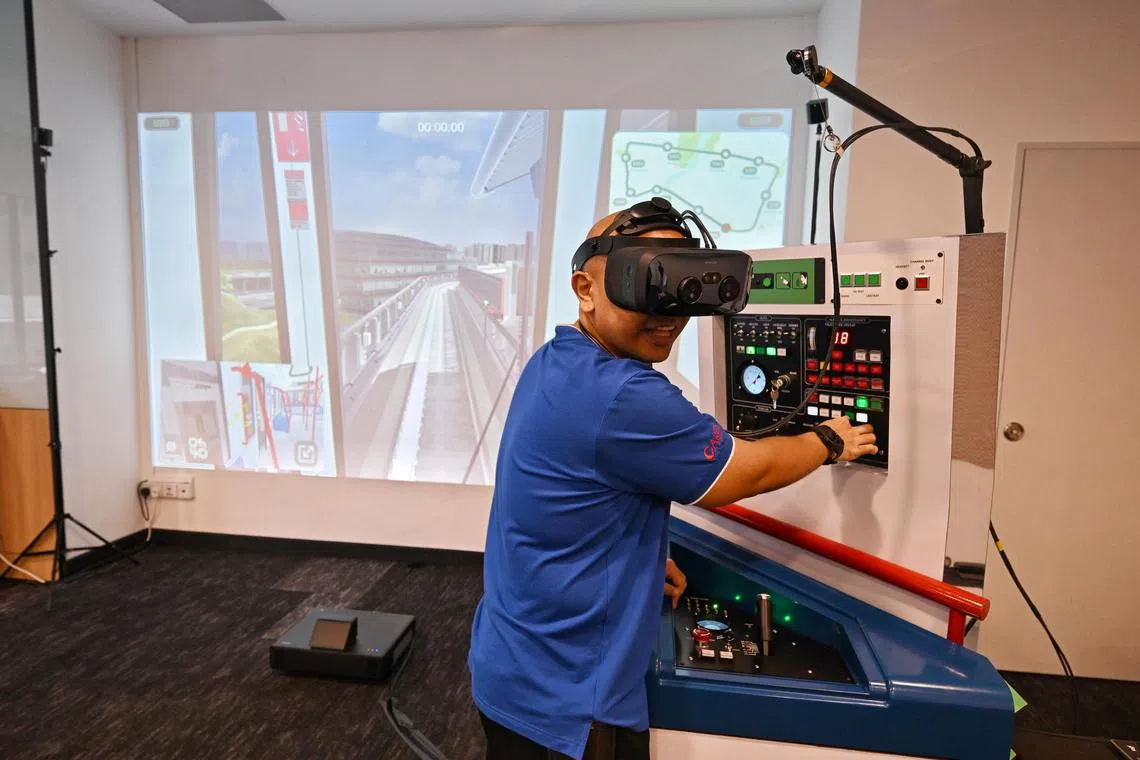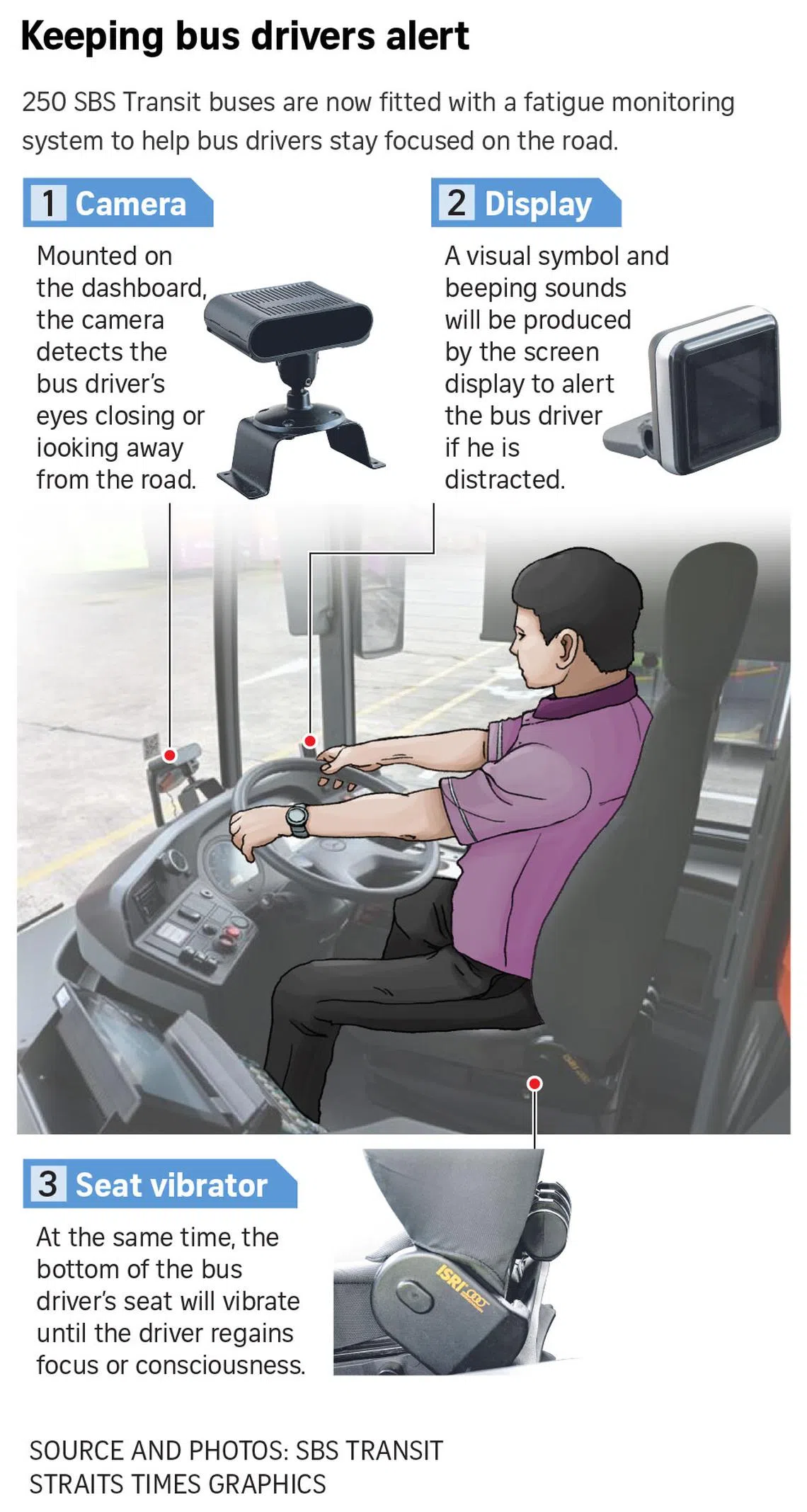‘Golden Eye’ helps SBS Transit bus drivers stay alert at the wheel
Sign up now: Get ST's newsletters delivered to your inbox

The use of Golden Eye, a fatigue monitoring system, being demonstrated by bus captain Guek Peng Kian.
ST PHOTO: SHINTARO TAY
Follow topic:
SINGAPORE – Whenever he operates service 51 from Jurong East to Hougang, bus captain Guek Peng Kian finds it challenging to stay focused towards the end of each journey, which lasts more than 2½ hours.
A bus captain for about five years, the 47-year-old finds the new fatigue monitoring system – complete with audiovisual alerts and vibrations – helpful in keeping him alert while driving, especially during longer journeys and on hot days.
Rolled out by public transport operator SBS Transit, the system – Golden Eye – comes with a dashboard-mounted camera that can detect signs of fatigue or distraction in bus drivers, by sensing that their eyes have been closed for two seconds or that they have been looking away – upwards or downwards – for four seconds or more.
Once these are detected, Golden Eye will send audio and visual alerts via a screen next to the camera, and produce seat vibrations powered by 24 volts.
Mr Guek, who has been using the system for about two years, said he is happy it will be installed on more buses, and hopes for it to be set up on all buses to ensure greater safety for everyone.
First trialled in 2019, Golden Eye is currently installed on 250 buses, or 7 per cent of SBS Transit’s fleet.
Singapore’s largest bus operator will be equipping close to 1,070 buses, or 30 per cent of its fleet, with the system by the end of 2024.
In response to The Straits Times’ query on when the system will be rolled out across its entire fleet, SBS Transit said Golden Eye will be installed progressively on its buses. It could not provide figures for the number of fatigue-related accidents involving its buses.
This fatigue monitoring system was on display at SBS Transit’s safety symposium at YWCA Fort Canning on May 10. Around 300 people – including overseas public transport operators and SBS Transit’s partners and contractors – attended the symposium.
Another safety feature on display was a “mixed-reality” light rail transit (LRT) driving simulator, which combines a virtual environment with physical tactile controls on a train console to hone trainees’ driving abilities.

Customer service officer Muhammad Hamzi Ismail, 35, demonstrating the use of the “mixed-reality” driving simulator.
ST PHOTO: SHINTARO TAY
It is equipped with a visual tracking feature for instructors to monitor what the trainees are looking at in real time, allowing them to give immediate feedback.
While SBS Transit had pushed out a similar virtual-reality railway safety trainer
The simulator can put trainees through various scenarios, which include an LRT train going too fast, rolling backwards or overshooting a station, and having a foreign object on the tracks.
The first batch of eight staff are undergoing training on the simulator, which was rolled out in April.
Among them is customer service officer trainee Muhammad Faiz, 27, who has just started training on an actual LRT train after training on the simulator for a month.
He said that the transition from the driving simulator to the actual train was not difficult as there were “no differences”, and he could apply what he learnt “exactly” to the train in reality.
SBS Transit is exploring the feasibility of using the mixed-reality simulator to train workers on the Downtown and North East MRT lines, which it operates.

To expand bus drivers’ field of vision, digital side mirrors are also being trialled, said SBS Transit group chief executive Jeffrey Sim.
Speaking at the symposium, Mr Sim said these mirrors can automatically adjust brightness levels to reduce glare on sunny days and increase brightness in the evenings.
He added that these mirrors are installed on 31 buses plying the routes of service 57 linking Bishan and Bukit Merah, and service 502 between Boon Lay and the Central Business District. The trial will be expanded to include more buses in 2024.
SBS Transit also signed five memorandums of understanding on May 10 with its partners, including one with Singapore-based Kabam Robotics to develop a multi-role robot.
The robot can patrol bus interchanges and MRT stations to keep a lookout for security issues, such as unattended bags, and broadcast safety-related messages, on top of cleaning floors.
It is being trialled at Little India station on the Downtown Line.
Additionally, an agreement with ST Engineering Mobility Services was inked to develop an all-round blind spot detection system.
Senior Minister of State for Transport Amy Khor said at the symposium that while workplace fatalities and non-fatal major injuries in Singapore dipped in 2023, the transport industry should not rest on its laurels and should always aspire towards a zero-accident rate.
Singapore’s workplace fatality rate per 100,000 workers fell from 1.3 in 2022 to 0.99 in 2023, while non-fatal major workplace injuries fell from 614 in 2022 to 590 cases in 2023, noted Dr Khor.
She reiterated the importance of technology and innovation as means of improving and promoting workplace safety.

